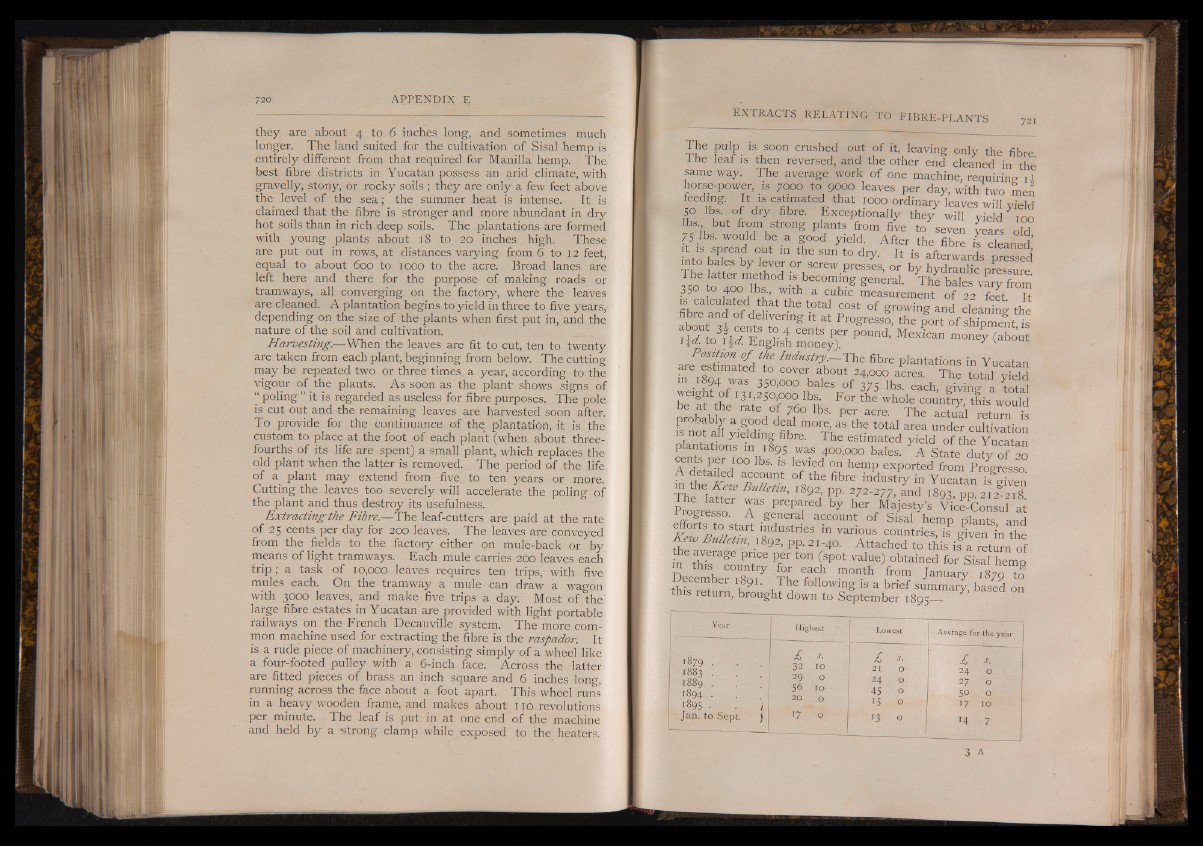
they are about 4 to 6 inches long, and sometimes much
longer. The land suited for the cultivation of Sisal hemp is
entirely different from that required for Manilla hemp. The
best fibre districts in Yucatan possess an arid climate, with
gravelly, stony, or rocky soils ; they are only a few feet above
the level of the sea; the summer heat is intense. It is
claimed that the fibre is stronger and more abundant in dry
hot soils than in rich deep soils. The plantations are formed
with young plants about 18 to 20 inches high. These
are put out in rows, at distances varying from 6 to 12 feet,
equal to about 600 to 1000 to the acre. Broad lanes are
left here and there for the purpose of making roads or
tramways, all converging on the factory, where the leaves
are cleaned. A plantation begins to yield in three to five years,-
depending on the size of the plants when first put in, and the
nature of the soil and cultivation.
Harvesting.— When the leaves are fit to cut, ten to twenty
are taken from each plant, beginning from below. The cutting
may be repeated two or three times, a year, according to the
vigour of the plants. As soon as the plant shows signs of
“ poling ” it is regarded as useless for fibre purposes. The pole
is cut out and the remaining leaves are harvested soon after.
To provide for the continuance of the) plantation, it is the
custom to place at the foot of each plant (when about three-
fourths of its life are spent) a small plant, which replaces the
old plant when the latter is removed. The period of the life
of a plant may extend from five to ten years or more.
Cutting the leaves too severely will accelerate the poling of
the plant and thus destroy its usefulness.
Extracting the Fibre.— The leaf-cutters are paid at the rate
of 25 cents per day for 200 leaves. The leaves are conveyed
from the fields to the factory either pn mule-back or by
iheans of light tramways. Each mule carries 200 leaves each
trip; a task o f 10,000 leaves requires ten trips, with five
mules each. On the tramway a mule can draw a wagon
with 3000 leaves, and make five trips a day. Most of the
large fibre estates in Yucatan are provided with light portable
railways on the French Decauville system. The more common
machine used for extracting the fibre is the raspador. It
is a rude piece of machinery, consisting simply of a wheel like
a four-footed pulley with a 6-inch face. Across the latter
are fitted pieces of brass an inch square and 6 inches long,
running across the face about a foot apart. This wheel runs
in a heavy wooden frame, and makes about 116 revolutions
per minute. The leaf is put in at one end of the machine
and held by a strong clamp while exposed to the heaters.
The pulp_ is soon crushed out of it, leaving only the fibre
The leaf is then reversed, and the other end cleaned in the
same way. The average work of one machine, requiring i i
horse-power, is 7000 to 9000 leaves per day, with two men
feeding. It is estimated that 1000 ordinary leaves will yield
SO lbs. of dry fibre. Exceptionally they will yield 100
lbs but from strong plants from five to seven years old
75 .lbs. would be a good yield. After the fibre is cleaned
it is spread out J the sun to dry. g | afterwards pressed
The fetter method °/hSCrew.Presses> or by hydraulic pressure.
I 50 to i i lbs t th aC°mKng generaL 35° to 400 lbs., with a cubic measuremTehnet boafl e2s 2v afreye tf romIt
is calculated that the total cost of growing and cleaning the
I f l i g l m — the fort ■ H H @ 2
moneyT P° “ " d' MeXiC“
J B a M g | 9 H H fibre Potation s in Yncatan
are estimated to cover about 24,000 acres. The total vield
m .1894 was 3So,ooo bales of 375- lbs. each, givin- a total
be k m ,° f 76o lbs. Fp°err tahcer ew. hoTIeh 4e 'a*ctu al “ reat u»r»n awis
Srnofan y i d d i l fib H t0tal area Under ^tivation
p l a n t a t i o n s I S H I estimated yield of the Yucatan
H H f *as prepared by her Majesty's Vi’ce -C o n L la t
Frogresso. A general account of Sisal hemp plants and
^ b // industries in various countries, is given in the
Kew Bulletzn, 1892, pp. O B Attached to this is^a retorn of
in thTsraS uPntrv E P I I S V ? obtained for Sisal hemp
December Dku Th S m°nth [TOm JanuaiT '*79 to
I R a f ! k u , 6 following 13 a brief summary, based on
return, brought down to September 1895:_
1879
Year
1
Highest
1 S.
32 IO
29 O
■56 IO
20 O
* • 1
to Sept. J 17 O
Lowest Average for the year
m S» s.
21 0 24 0
24 0 27 0
45 0 So 0
15 , 0 17 10
13
°
14 7